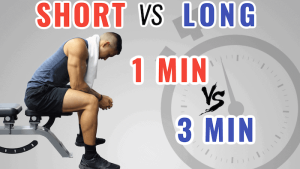The amount of time your muscles spend under contraction, the volume of activity being completed, and the amount of time spent in rest all influence the outcome of your training. Sets, reps, rest, and movement all work together to create an optimal stimulus for muscular adaptations. The amount required for each of these is entirely based on your goals and what you are trying to achieve.
To get a better understanding of it all, it is important to firstly define some exercise terms:
Reps: Short for repetition and is a single execution of an exercise. One squat is one rep, and 12 squats is 12 reps.
Sets: A set is a collection of reps. It includes completing a bout of exercise followed by a rest.
Rest: The time spent resting the muscle which has been worked between sets.
Volume: The total amount of work being completed, calculated by multiplying the sets and reps.
Concentric and Eccentric (Tempo):
Contraction velocity is the speed at which one rep of an exercise is performed. Concentric muscle contraction includes shortening the muscle and often occurs through the lifting part of a rep whereas eccentric muscle contraction includes lengthening the muscle and is often through lowering. Both contractions work together and are important in building muscle mass, however the optimal duration for each type of training varies.
Types of Training
Hypertrophy training: This type of training is for the purpose of building muscle size and includes lifting light to moderate weights for three to six sets and between six to 12 times. Hypertrophy training requires metabolic stress to ensure muscle breakdown so it can build back up (with the help of rest and nutrition) to achieve greater size.
Muscular endurance: Endurance training requires the highest number of reps per set coupled with the shortest amount of rest (≤30 seconds). This is because it challenges the muscles’ ability to maintain work throughout an extended amount of time. To do this, the only option is to complete endurance training with lighter weights.
Strength: To build muscular strength, the neuromuscular system adapts to lifting heavy weights by increasing its ability to do so when provided that stimulus. Higher rests are required to allow the body to make and prepare for these adaptations. Therefore, this training requires lifting the highest possible weight for short reps and low to moderate sets. This type of training is best supported with longer rests lasting between two to five minutes to ensure sufficient energy per contraction.
Power: Power is the ability to move an object or create movement at high speeds. This type of training relies more highly on the speed of movement (concentric and eccentric contractions) than the volume of activity. In power training, the concentric (beginning portion) of the movement should be completed at a quick tempo for each execution. This type of training requires practicing the acceleration part of a lift, then resting and repeating so would require moderate to heavy weights to be successful. To ensure optimal power can be utilized per execution, a low rep range of one to three reps for three to five sets is sufficient.
Exercising for General Fitness
Exercising for general fitness includes an optimal volume of training to increase strength and muscle capacity. Completing between eight and 15 reps for two to four sets will help you accomplish both objectives. For this type of training, it’s important to select moderate weights where you feel fatigued by the last rep, but this shouldn’t be excessively difficult or impossible to complete. Allow 30 to 60 seconds rest between sets however, if you require additional time to recover going over is appropriate as well. It is more important to listen to your body to maintain safe and effective exercise and to prevent injury than to follow guidelines to perfection.
| Type | Weight | Sets | Reps | Rest | Tempo |
| Muscular Endurance | Light | 2-3 | ≥12 | ≤30 sec | 1-2 sec concentric and eccentric |
| Hypertrophy | Light to moderate | 3-6 | 6-12 | 30 – 90 sec | 2-5 sec concentric and eccentric |
| General Fitness | Moderate | 2-3 | 8-15 | 30-90 seconds | 2-3 seconds concentric and eccentric |
| Strength | Moderate to Heavy | 2-6 | ≤6 | 2 – 5 min | 1-2 sec concentric and eccentric |
| Power | Heavy | 3-5 | 1-3 | 2 – 5 min | <1 sec concentric, 1-2 seconds eccentric |
For all types of training, it is important to achieve the desired sets and reps whilst maintaining the correct form. This means selecting an appropriate weight where you feel challenged when reaching the end few reps. There is no specific load to define ‘light’, ‘moderate’ and ‘heavy’ weights, this measure is relative to your exercise capacity. Although altering the sets, reps, tempo, and rest can complement and help achieve your goals, this is only one important factor in training. It is equally important to fuel your body with the right type and amount of food to ensure it can recover and be supported in making muscular adaptations between exercise sessions.




